
Nageia is a genus of conifers belonging to the podocarp family Podocarpaceae. Nageia includes evergreen shrubs and trees, from one to 54 meters in height. A 2009 treatment of the genus recognized five species. Some authors consider Nageia formosensis to be a separate species from Nageia nagi, thus recognizing six species. The podocarp genera have been reshuffled by various botanists. Most recently, several species formerly classed as Nageia were moved to the new genus Retrophyllum, while Nageia falcata and Nageia mannii were moved to the new genus Afrocarpus.
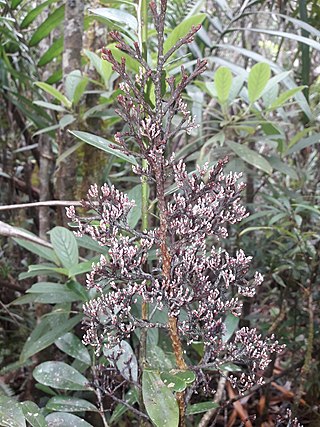
Parasitaxus usta is a rare species of conifer of the family Podocarpaceae, and the sole species of the genus Parasitaxus. It is a woody shrub up to 1.8 m found only in the remote, densely forested areas of New Caledonia, first discovered and described by Vieillard in 1861. The first definitive report that it was a parasite was in 1959.

Abies lasiocarpa, the subalpine fir or Rocky Mountain fir, is a western North American fir tree.
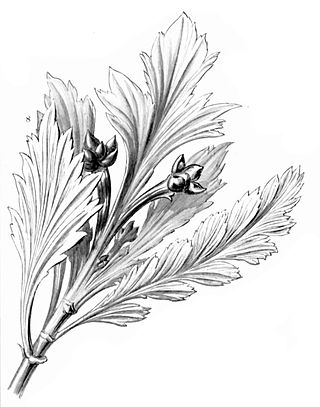
Phyllocladus aspleniifolius, commonly known as the celerytop pine, is an endemic gymnosperm of Tasmania, Australia. It is widespread and common in Tasmania, with the most abundance in the western highlands. Its ‘leaves’ appear similar to those of a celery plant, hence the common name.

The Santa Cruz cypress is a species of North American tree within the Cypress family. The species is endemic to the Santa Cruz Mountains within the Santa Cruz and San Mateo counties of west-central California. The U.S. Fish and Wildlife Service listed the species on the Endangered Species Act in 1987 due to increasing threats from habitat loss and disruption of natural forest fire regimes. In 2016, the conservation status of the Santa Cruz cypress changed to Threatened. The cited reasoning was a decrease in threats against their habitat.

Cupressus torulosa, commonly known as the Himalayan cypress or Bhutan cypress, is a species of cypress tree native to the mountainous northern regions of the Indian subcontinent, in the western Himalayas.
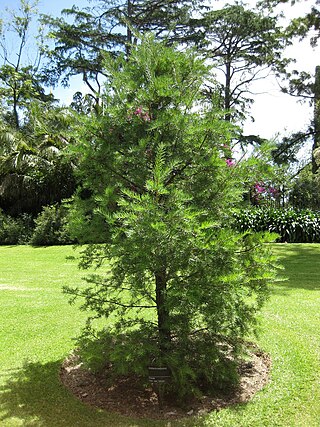
Keteleeria evelyniana is a species of conifer native to southern China, Laos and Vietnam. It can grow to a height of 40 metres (130 ft).

Araucaria nemorosa is a species of conifer in the family Araucariaceae. It is found only in New Caledonia, an island possession of France in the South Pacific. It is mostly found as a small understory tree, typically growing to no more than 15 meters, and relatively shade tolerant, though it can also grow as an emergent from coastal scrub. It has feathery foliage somewhat less spiky than most other Araucaria species, and is found only on serpentine soil, in coastal locations below 100m in altitude. It is threatened by habitat loss and is a critically endangered species with less than 5000 trees remaining in the wild. Low levels of genetic variation in the remaining population and consequent low germination rates of seed produced, are also a concern.

Athrotaxis cupressoides, is also known as pencil pine, despite being a species of the family Cupressaceae, and not a member of the pine family. Found either as an erect shrub or as a tree, this species is endemic to Tasmania, Australia. Trees can live for upwards of 1000 years, sustaining a very slow growth rate of approximately 12 mm in diameter per year.
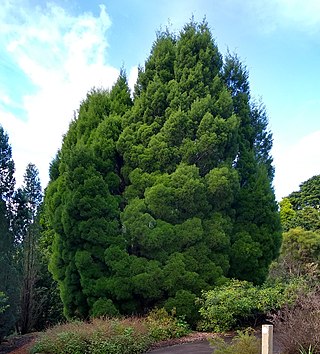
Callitris baileyi is a species of conifer in the family Cupressaceae. It is found only in Australia, more specifically Southeast Queensland. Its common English name is Bailey's cypress-pine. The name is dedicated to Australian botanist Frederick Manson Bailey, who was the first to collect specimens of this tree. Bailey's name is closely associated with much of the flora of Queensland and their elucidation in Southeastern Queensland. Over the past few decades the conifer has been severely threatened by habitat loss Fruiting for the species has been recorded year-round.
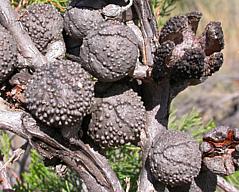
Callitris verrucosa, also known as the mallee pine, is a species of conifer in the family Cupressaceae. It is found only in Australia. The plant has a green/grey colour, rigid branches and can reach a height of 8 metres (26 ft). It has a slow grow rate.
Dacrydium gracile is a species of conifer in the family Podocarpaceae. It is found only in Malaysian Borneo.
Falcatifolium angustum is a species of conifer in the family Podocarpaceae found only in Malaysia. it can grow up to twenty meters tall. It is threatened by habitat loss, in 1998 it was known to exist only in two locations, both in Sarawak.
Falcatifolium sleumeri is a species of conifer in the family Podocarpaceae. It is found only in a small area in the far west of Western New Guinea (Papua).
Falcatifolium taxoides is a species of conifer in the family Podocarpaceae. It is found only in New Caledonia, and is the only known host of its non-photosynthetic, possibly parasitic relative, Parasitaxus usta.

Podocarpus angustifolius is a species of conifer in the family Podocarpaceae. It is endemic to Cuba.
Podocarpus borneensis is a species of conifer in the family Podocarpaceae. It native to the island of Borneo, which is divided between Indonesia and Malaysia.

Podocarpus laetus is a species of conifer in the family Podocarpaceae, commonly known as Hall's tōtara, mountain tōtara or thin-barked tōtara. Previously known as Podocarpus hallii and Podocarpus cunninghamii, in 2015 it was realised that the much earlier name P. laetus has priority. Its common name results from the species being named after J. W. Hall, a New Zealand pharmacist.
Podocarpus laubenfelsii is a species of conifer in the family Podocarpaceae. It is native to Borneo.













